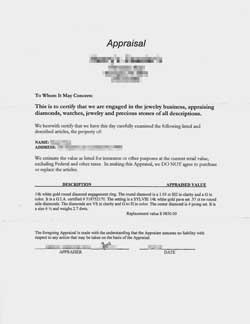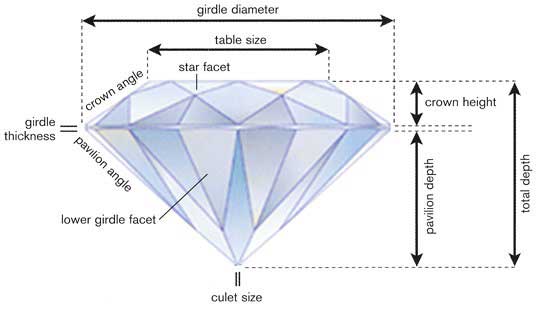Evaluating a jewelry appraisal
 In settling auto losses, lots of details are needed. Is it any different for jewelry losses?
In settling auto losses, lots of details are needed. Is it any different for jewelry losses?
No. But getting those jewelry details is the issue.
For cars --
There is a standardized VIN that identifies all the relevant details of the vehicle. The VIN standard has been used throughout the industry since the early 1980s. Repair shops follow agreed-upon pricing, and the adjuster's job is straightforward.
For jewelry –
There's no VIN — but there are standards for identifying the qualities that give jewelry its value. The standards were published by ACORD in 1997 and are currently available through JISO, Jewelry Insurance Standards Organization.
The problem is that the JISO standards are still not widely used.
Why is that a problem?
Jewelry insurers and adjusters depend on appraisals for descriptive information, but here's what they're up against:
Every appraisal looks different—in layout, in the order of things, in formality. Some are a paragraph long, some go on for pages. The appraisal may use unfamiliar words or obscure abbreviations.
There's a valuation at the bottom, but how complete is the description? In the event of a loss, is there enough detail to order a replacement?
Unpacking an appraisal
Let's look at a typical appraisal received by one insurer for a diamond engagement ring. It's in a narrative form, so the underwriter or adjuster must "unpack" it to see just what information is included.
ACORD/JISO 18 Evaluation form facilitates that unpacking, as details from the appraisal are copied onto a standardized format.
Although this appraisal carries a lot of specifics, highlighting on the JISO Evaluation form shows that a number of crucial details are missing from the appraisal. (Enlarge the Evaluation, so you can see what's highlighted.)
- There is no information on Cut, the most important of the 4 Cs! The proportioning of a diamond—its table %, crown angle, girdle thickness, and pavilion %—accounts for up to 50% of the gem's value. It is impossible to calculate an accurate valuation without this information.
TIP: Cut proportions are the details most frequently missing from diamond appraisals. This omission, especially from appraisals done by the seller, happens because cut is so important to valuation. Revealing poor proportioning greatly reduces the purported value of the diamond.
- Workmanship of the mounting is also left blank. Whether the piece was cast, die-struck, handmade, machine-made, etc., makes a huge difference in mounting valuation.
- No sales receipt is included with the submission.
TIP: For recent purchases, the receipt is a useful tool as it represents actual value in the current market. Though the seller may have lured the customer with a "discount," a selling price significantly lower than the appraised valuation suggests an inflated valuation.
- A GIA diamond report is referenced on the appraisal but the report is not included with the submission. The underwriter looked it up on GIA's online Report Check but found no such number.
TIP: Always verify a report number, and don't rely on reports from bogus labs. There are fake lab report numbers, fraudulent reports with descriptions that don't match the gem that is up for coverage, and reports from completely nonexistent labs. Maybe this report number just has a typo, an innocent error that can be cleared up by asking the insured for the GIA report. In any case, all existing lab reports should be in the insurer's files.
Result based on the JISO 18 Evaluation: Before offering coverage, the insurer required the insured to obtain
- cut proportions of the diamond
- the jewelry's workmanship
- GIA report
- sales receipt
The underwriter suggested that the customer show the seller the Evaluation with omissions highlighted, and ask for a more complete appraisal (which the customer had already paid for).
The underwriter also gave the insured a copy of JISO 806 for the appraiser to complete, since a JISO appraisal gains the insured a premium discount from some insurers.
Jewelry Insurance Appraisal Standards exist! The JISO appraisal forms prompt appraisers for all details necessary for jewelry description and valuation, so nothing is left out. The format makes it easy for insurers to see at a glance whether necessary details are included.
Though these JISO docs all look the same, there are distinctions.
JISO 78 (appraisal for a single item) and JISO 79 (for multiple items) are the gold standard, because they can be completed only by a GG or FGA+ who has additional jewelry insurance training (such as a Certified Insurance Appraiser™).
These credentials, along with the appraiser's warrantee and other information of value to both insurer and consumer, are described on the back of the appraisal and constitute part of the appraisal.
JISO 805, Jewelry Sales Receipt for Insurance Purposes, is to be filled out by the seller. It specifies that the valuation is the actual price paid by the buyer in that store. Given the prevalence of inflated jewelry appraisals, this is an important feature.
JISO 806, Jewelry Document for Insurance Purposes, can be filled out by any jewelry appraiser. The prompts for all necessary info diminish the chance that details will be inadvertently overlooked.
If the appraiser in the above case had used a JISO appraisal, delays could have been avoided. There would be no extra work by the underwriter, no additional trip by insured to the appraiser. In addition, in the event of a loss, the replacement would be more accurate.
A JISO appraisal better protects the insured and promotes customer goodwill. The forms are available free of charge on JISO.org.
FOR AGENTS & UNDERWRITERS
All jewelry of substantial value should be scheduled and have an appraisal from a reliable and trained gemologist appraiser, preferably one who is independent of the seller.
All jewelry details on the appraisal—and details left off an appraisal—affect valuation. Without essential information on the appraisal, an adjuster would have to guess at the jewelry's quality. And the wrong guess could result in a very dissatisfied customer.
Many appraisals have inflated valuations, which create moral hazard (and overpriced insurance). Ask for the sales receipt.
The best appraisal includes the JISO 78/79 appraisal form and is written by a qualified gemologist (GG, FGA+, or equivalent), who has additional insurance appraisal training. One course offering such additional training is the Certified Insurance Appraiser™ (CIA) course of the Jewelry Insurance Appraisal Institute.
If the insured needs an appraisal, and a GG or FGA+ is not available in your locale, print out JISO 806 and recommend your client have a local appraiser complete it. (Some appraisers include a JISO 806 appraisal along with an appraisal in their preferred format.)
All high-value jewelry should have a grading report from a respected lab. We recommend the following labs, and you can use these links to check the authenticity of reports that you receive.
Gemological Institute of America GIA Report Check
American Gem Society Lab AGS Report Verification
Gem Certification and Assurance Lab GCAL Certificate Search
FOR ADJUSTERS
Use the appraisal's descriptive data, rather than its valuation, to price a replacement.
Keep in mind that often appraisals supplied by the seller are sales tools meant to impress the buyer. Their valuations may have little real-world basis. If the appraisal shows a valuation considerably higher than the sales receipt, suspect an inflated valuation.
Your job is easier if you are dealing with a JISO 78/79 Jewelry Appraisal, or JISO 806 Jewelry Document for Insurance Purposes, or JISO 805 detailed Sales Receipt, since they will give complete information in a standardized format.
If one of the above is not available, use JISO 18 to analyze data from the documents you have. This is especially helpful if you're faced with a "narrative" appraisal. JISO 18 allows you to order the information from other documents in a useful way and see what details may be missing.
Lab-made gems are worth less than mined gems. Check the appraisal for the words like lab-made, lab-grown, and synthetic.
Check the appraisal for the terms fracture-filled, treated, and enhanced, as such gems are worth substantially less than untreated stones.
©2000-2025, JCRS Inland Marine Solutions, Inc. All Rights Reserved. www.jcrs.com



